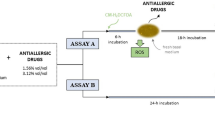Abstract
Introduction
The aim of this study is to investigate potential adverse effects of fixed combination glaucoma medications preserved with either benzalkonium chloride (BAK) or Polyquad® (PQ; Alcon Research Ltd., Fort Worth, TX, USA) on cultured ocular epithelial cells.
Methods
Confluent cultures of human cornea and conjunctival cell lines were exposed for 25 minutes to different glaucoma medications as well as a range of concentrations of BAK (0.001%–0.050%). Balanced salt solution was used as the “live” control and a solution containing 70% methanol and 0.2% saponin was used as a “dead” control. The number of dead and live cells were determined via ethidium homodimer (Eth-1) and calcein acetoxymethyl ester (AM) fluorescence, respectively.
Results
The toxicity of the prostaglandin analog with beta-blocker timolol fixed-combination formulations preserved with BAK was different from that observed in the respective BAK concentrations. Travoprost plus timolol fixed combination with BAK performed better than its respective BAK concentration alone, while the latanoprost plus timolol fixed combination performed worse than its respective BAK concentration. Travoprost plus timolol fixed combination preserved with PQ had greater corneal and conjunctival cell survival than either the travoprost plus timolol fixed combination preserved with BAK or the latanoprost plus timolol fixed combination.
Conclusion
Ocular surface side effects have previously been demonstrated with chronic, long-term exposure to intraocular-pressure-lowering medications containing the common preservative BAK. BAK alone has significant in-vitro cytotoxicity to cultured ocular epithelial cells. Substitution of BAK with PQ resulted in significantly higher percentages of live conjunctival and corneal cells. Further studies are needed to understand the clinical implications of these findings.
Similar content being viewed by others
References
Noecker RJ, Herrygers LA, Anwaruddin R. Corneal and conjunctival changes caused by commonly used glaucoma medications. Cornea. 2004;23:490–496.
Pisella PJ, Debbasch C, Hamard P, et al. Conjunctival proinflammatory and proapoptotic effects of latanoprost and preserved and unpreserved timolol: an ex vivo and in vitro study. Invest Ophthalmol Vis Sci. 2004;45:1360–1368.
Horsley MB, Kahook MY. Effects of prostaglandin analog therapy on the ocular surface of glaucoma patients. Clin Ophthalmol. 2009;3:291–295.
Kahook MY, Noecker RJ. Comparison of corneal and conjunctival changes after dosing of travoprost preserved with sofZia, latanoprost with 0.02% benzalkonium chloride, and preservative-free artificial tears. Cornea. 2008;27:339–343.
Ammar DA, Noecker RJ, Kahook MY. Effects of benzalkonium chloride-preserved, polyquad-preserved, and sofZia-preserved topical glaucoma medications on human ocular epithelial cells. Adv Ther. 2010;27:837–845.
De Saint Jean M, Debbasch C, Brignole F, Rat P, Warnet JM, Baudouin C. Toxicity of preserved and unpreserved antiglaucoma topical drugs in an in vitro model of conjunctival cells. Curr Eye Res. 2000;20:85–94.
Noecker R. Effects of common ophthalmic preservatives on ocular health. Adv Ther. 2001;18:205–215.
Blondin C, Hamard P, Cholley B, Haeffner-Cavaillon N, Baudouin C. In vitro effects of preserved or preservative-free antiglaucoma medications on human complement system. Curr Eye Res. 2003;27:253–259.
Guenoun JM, Baudouin C, Rat P, Pauly A, Warnet JM, Brignole-Baudouin F. In vitro study of inflammatory potential and toxicity profile of latanoprost, travoprost, and bimatoprost in conjunctiva-derived epithelial cells. Invest Ophthalmol Vis Sci. 2005;46:2444–2450.
Whitson JT, Cavanagh HD, Lakshman N, Petroll WM. Assessment of corneal epithelial integrity after acute exposure to ocular hypotensive agents preserved with and without benzalkonium chloride. Adv Ther. 2006;23:663–671.
Yee RW, Norcom EG, Zhao XC. Comparison of the relative toxicity of travoprost 0.004% without benzalkonium chloride and latanoprost 0.005% in an immortalized human cornea epithelial cell culture system. Adv Ther. 2006;23:511–519.
Epstein SP, Ahdoot M, Marcus E, Asbell PA. Comparative toxicity of preservatives on immortalized corneal and conjunctival epithelial cells. J Ocul Pharmacol Ther. 2009;25:113–119.
Tripathi BJ, Tripathi RC, Kolli SP. Cytotoxicity of ophthalmic preservatives on human corneal epithelium. Lens Eye Toxic Res. 1992;9:361–375.
Lopez Bernal D, Ubels JL. Quantitative evaluation of the corneal epithelial barrier: effect of artificial tears and preservatives. Curr Eye Res. 1991;10:645–656.
Guenoun JM, Baudouin C, Rat P, Pauly A, Warnet JM, Brignole-Baudouin F. In vitro comparison of cytoprotective and antioxidative effects of latanoprost, travoprost, and bimatoprost on conjunctiva-derived epithelial cells. Invest Ophthalmol Vis Sci. 2005;46:4594–4599.
Wu KY, Wang HZ, Hong SJ. Cellular cytotoxicity of antiglaucoma drugs in cultured corneal endothelial cells. Kaohsiung J Med Sci. 2007;23:105–111.
Ammar DA, Kahook MY. The effects of combination glaucoma medications on ocular surface epithelial cells. Adv Ther. 2009;26:970–975.
Brasnu E, Brignole-Baudouin F, Riancho L, Warnet JM, Baudouin C. Comparative study on the cytotoxic effects of benzalkonium chloride on the Wong-Kilbourne derivative of Chang conjunctival and IOBA-NHC cell lines. Mol Vis. 2008;14:394–402.
De Saint Jean M, Brignole F, Bringuier AF, Bauchet A, Feldmann G, Baudouin C. Effects of benzalkonium chloride on growth and survival of Chang conjunctival cells. Invest Ophthalmol Vis Sci. 1999;40:619–630.
Champeau EJ, Edelhauser HF. Effect of ophthalmic preservatives on the ocular surface: conjunctival and corneal uptake and distribution of benzalkonium chloride and chlorhexidine digluconate. In: Holly FJ, Lamberts DW, MacKeen DL, eds. The Preocular Tear Film in Health, Disease, and Contact Lens Wear. Lubbock, TX: Dry Eye Institute; 1986:292–302.
Author information
Authors and Affiliations
Corresponding author
Rights and permissions
About this article
Cite this article
Ammar, D.A., Noecker, R.J. & Kahook, M.Y. Effects of benzalkonium chloride- and polyquad-preserved combination glaucoma medications on cultured human ocular surface cells. Adv Therapy 28, 501–510 (2011). https://doi.org/10.1007/s12325-011-0029-x
Received:
Published:
Issue Date:
DOI: https://doi.org/10.1007/s12325-011-0029-x




